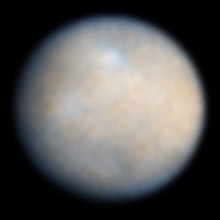మరుగుజ్జు గ్రహం
మరుగుజ్జు గ్రహం (ఆంగ్లం Dwarf Planet), లేదా 'చిన్న గ్రహం', అంతర్జాతీయ ఖగోళ సమాఖ్య (IAU) నిర్వచనం ప్రకారం, ఒక అంతరిక్ష వస్తువు, సూర్యుని చుట్టూ పరిభ్రమిస్తూ, తగినంత బరువును కలిగి, గోళాకృతిని కలిగి, స్వంత గురుత్వాన్ని కలిగి, గ్రహానికి కావలసిన 'ఇరుగు పొరుగు ప్రాంతం' ను పొందివుండ లేక, ఉపగ్రహమూ కానిది.[1][2] ఇంకా విపులంగా, దీనికి గోళాకృతి పొందడానికి కావలసిన బరువు ఉన్ననూ గ్రహానికి కావలసిన 'ఇరుగు పొరుగు ప్రాంతం' లేకపోవడం వల్ల ఏర్పడిన గ్రహం కాని గ్రహం ఈ మరుగుజ్జు గ్రహం.

లక్షణాలు మార్చు
వీటి లక్షణాలను గమనించండి;
| శరీరం | Mass (ME*) |
Λ/ΛE** |
µ*** |
|---|---|---|---|
| బుధుడు | 0.055 | 0.0126 | 9.1×104 |
| శుక్రుడు | 0.815 | 1.08 | 1.35×106 |
| భూమి | 1.00 | 1.00 | 1.7×106 |
| అంగారకుడు | 0.107 | 0.0061 | 1.8×105 |
| సెరిస్ | 0.00015 | 8.7×10−9 | 0.33 |
| బృహస్పతి | 317.7 | 8510 | 6.25×105 |
| శని | 95.2 | 308 | 1.9×105 |
| యురేనస్ | 14.5 | 2.51 | 2.9×104 |
| నెప్ట్యూన్ | 17.1 | 1.79 | 2.4×104 |
| ప్లూటో | 0.0022 | 1.95×10−8 | 0.077 |
| ఎరిస్ | 0.0028 | 3.5×10−8 | 0.10 |
*ME భూమి బరువులో .
**Λ/ΛE = M²/P, in Earth masses squared per year.
***µ = M/m, where M is the mass of the body,
and m is the aggregate mass of all the other bodies
that share its orbital zone.
సమకాలీన సభ్యులు మార్చు
అంతర్జాతీయ ఖగోళ సమాఖ్య (IAU) ఈ మూడు అంతరిక్ష వస్తువులను, 'మరుగుజ్జు గ్రహాలు' గా, నిర్ణయించింది:[4]
- సెరిస్ – 1801 జనవరి 1 న కనుగొనబడింది. (16 నెప్ట్యూన్ కంటే 16 సంవత్సరాల్కు పూర్వమే, అర్ధ శతాబ్దం 'గ్రహం' గానే పరిగణింప బడుతూ, ఆస్టెరాయిడ్ గా స్థిరపడింది;
- ప్లూటో – 1930 ఫిబ్రవరి 18, గ్రహంగా 76 సంవత్సరాలు పరిగణింపబడినది;
- ఎరిస్ – 2003 అక్టోబరు 21 న కనుగొనబడింది. ఒకప్పుడు నెప్ట్యూన్ కు ఆవల, 10వ గ్రహంగా పరిగణింపబడింది.
ఈ మూడు వస్తువుల పోలికలు :
| Orbital attributes of dwarf planets[5] | |||||||||||
|---|---|---|---|---|---|---|---|---|---|---|---|
| Name | సౌరమండలము లో స్థానం |
కక్ష్య వ్యాసార్ధము (ఎ.యు.) |
పరిభ్రమణ కాలం (సం.లో ) |
సగటు పరిభ్రమణ వేగము (కి.మీ./సె.) |
Inclination to ecliptic (°) |
Orbital eccentricity |
Planetary discriminant | ||||
| సెరిస్ | ఆస్టెరాయిడ్ పట్టీ | 2.77 | 4.60 | 17.882 | 10.59 | 0.080 | 0.33 | ||||
| ప్లూటో | క్యూపర్ బెల్ట్ | 39.48 | 248.09 | 4.666 | 17.14 | 0.249 | 0.077 | ||||
| ఎరిస్ | విసరబడ్డ డిస్క్ | 67.67 | 557 | 3.436 | 44.19 | 0.442 | 0.10 | ||||
| Physical attributes of dwarf planets | |||||||||||||
|---|---|---|---|---|---|---|---|---|---|---|---|---|---|
| Name | Relative equatorial diameter[E] |
Equitorial diameter (km) |
Relative mass[E] |
Mass (×1022 kg) |
Density (×103g/m³) |
Surface gravity (m/s2) |
Escape velocity (km/s) |
Axial inclination |
Rotation period (days) |
సహజసిద్ధ ఉపగ్రహాలు | Surface temp. (K) |
వాతావరణం | |
| సెరిస్[6][7] | 0.074 | 974.6±3.2 | 0.0002 | 0.095 | 2.08 | 0.27 | 0.51 | ~3° | 0.38 | 0 | 167 | none | |
| ప్లూటో[8][9] | 0.19 | 2306±30 | 0.0021 | 1.305 | 2.0 | 0.58 | 1.2 | 119.59° | -6.39 | 3 | 44 | temporary | |
| ఎరిస్ [10][11] | 0.19 | 2400±100 | 0.0025 | 1.67 | 2.3 | ~0.8 | 1.3 | ~0.3 | 1 | 42 | temporary | ||
| |||||||||||||
ఇవీ చూడండి మార్చు
మూలాలు మార్చు
- ↑ "IAU 2006 General Assembly: Result of the IAU Resolution votes". International Astronomical Union. 2006. Archived from the original on 2007-01-03. Retrieved 2008-01-26.
- ↑ "Dwarf Planets". NASA. Archived from the original on 2012-07-04. Retrieved 2008-01-22.
- ↑ ఉల్లేఖన లోపం: చెల్లని
<ref>ట్యాగు;soterఅనే పేరుగల ref లలో పాఠ్యమేమీ ఇవ్వలేదు - ↑ "IAU 2006 General Assembly: Result of the IAU Resolution votes". International Astronomical Union. 2006-08-26. Archived from the original on 2006-11-07. Retrieved 2008-01-26.
- ↑ ఉల్లేఖన లోపం: చెల్లని
<ref>ట్యాగు;asteroidorbitఅనే పేరుగల ref లలో పాఠ్యమేమీ ఇవ్వలేదు - ↑ Thomas, P.C; Parker J.Wm.; McFadden, L.A. (2005). "Differentiation of the asteroid Ceres as revealed by its shape". Nature. 437: 224–26. doi:10.1038/nature03938. Retrieved 2008-02-16.
{{cite journal}}: CS1 maint: multiple names: authors list (link) - ↑ Calculated based on the known parameters. APmag and AngSize generated with Horizons (Ephemeris: Observer Table: Quantities = 9,13,20,29)
- ↑ Williams, D.R. (2006-09-07). "Pluto Fact Sheet". NASA. Retrieved 2007-03-24.
- ↑ మూస:Citejournal
- ↑ Stansberry, John; Grundy, Will; Brown, Mike; Spencer, John; Trilling, David; Cruikshank, Dale; Margot, Jean-Luc (2007). "Physical Properties of Kuiper Belt and Centaur Objects: Constraints from Spitzer Space Telescope" (PDF). University of Arizona, Lowell Observatory, California Institute of Technology, NASA Ames Research Center, Southwest Research Institute, Cornell University. Retrieved 2007-05-18.
{{cite web}}: CS1 maint: multiple names: authors list (link) - ↑ మూస:Citejournal
- ↑ "The IAU draft definition of "planet" and "plutons"". International Astronomical Union. 2006-08-16. Archived from the original on 2008-02-10. Retrieved 2008-01-26.
Planet candidates in the Solar System artist's impression
బయటి లింకులు మార్చు
- NPR: Dwarf Planets May Finally Get Respect (David Kestenbaum)
- BBC News: Q&A New planets proposal, 16 August 2006
- Ottawa Citizen: The case against Pluto Archived 2007-02-24 at the Wayback Machine (P. Surdas Mohit) August 24 2006
- James L. Hilton, When Did the asteroids Become Minor Planets? Archived 2006-05-20 at the Wayback Machine